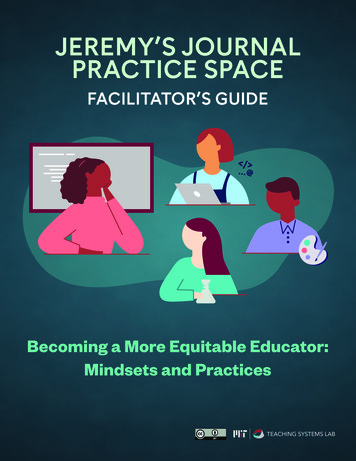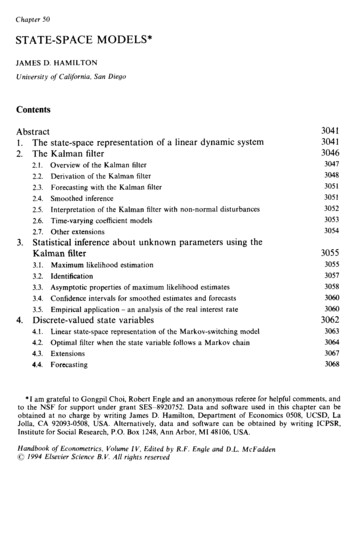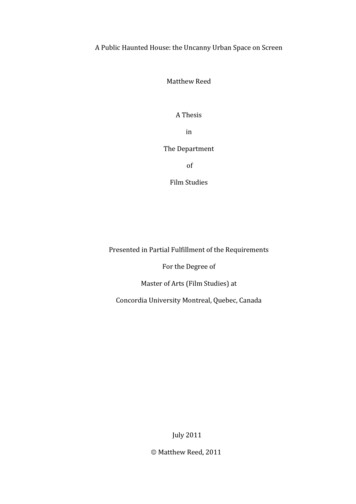
Transcription
JEREMY’S JOURNALPRACTICE SPACEFACILITATOR’S GUIDETEACHING SYSTEMS LABTEACHING SYSTEMS LABBecoming a More Equitable Educator:Mindsets and Practices1
Welcome to Jeremy’s Journal Facilitator’s GuideThis is a guide to help you facilitate Jeremy’s Journal practice space, a digital scenario developed by theTeaching Systems Lab to help teachers rehearse typical and challenging classroom moments.In this scenario, participants will experience a simulation focused on the work products and classroombehaviors of a single student.The goal of this activity is to guide educators in a conversation about the Equity and Equality EducatorMindsets. Participants will talk about the multiple factors that might impact students, the roles of teachersin the classroom, and the concept of shared responsibility when addressing student performance.We believe that mindsets like Equity and Equality are often out of balance in schools, and hope thatconversations and activities like these will help us begin to rebalance these mindsets. To learn more aboutthe Educator Mindsets, access our online course, Becoming a More Equitable Educator: Practices andMindsets or watch this video by instructor Richard Milner.The practice space should take between 60-90 minutes.IN THIS GUIDE YOU’LL FIND THE FOLLOWING SECTIONSGet Ready to Facilitate a Practice Space03Facilitating the Practice Space04Before starting the Practice Space (5-10 minutes)04During the Practice Space Digital Scenario (30 minutes)04Debrief Guide (20-40 minutes)05Next Steps (5-10 minutes)06Debrief TipsAppendices060707Appendix B. What are practice spaces?07Appendix C. Troubleshooting TeacherMoments07Appendix D. Handouts07Handout 1: Educator Mindsets Table: Equity versus Equality08Handout 2: Mindsets in the Practice Space- Jeremy’s Journal09Appendix E. Sample invitation email text10TEACHING SYSTEMS LABAppendix A. Want to dig deeper as a facilitator?2
Getting Ready to Facilitate a Practice SpacePREPARE YOURSELF Watch this video from instructor Justin Reich about facilitating practice spaces.Spend some time looking over the following documents. You’ll need to be familiar withthem to facilitate most effectively. The Jeremy’s Journal scenario itselfi. For help navigating TeacherMoments, watch this tutorial.ii. Make sure to fill out the survey at the end (it’s different from the one in thecourse); it helps us understand how people are using and sharing our materials. The Equity versus Equality Educator Mindset TableThe Debrief Guide and Mindsets in the Practice Space handout.For more resources, see Appendix A.SCHEDULE A TIME TO MEET We recommend planning 60-90 minutes to do the practice space with a group. Alonger time will give you more time to debrief. If you have less than 60 minutes,consider asking participants to complete the practice space individually beforemeeting. If you are new to facilitating equity conversations, you may want to consider inviting asmaller group of colleagues before sharing with a larger audience.GATHER NEEDED MATERIALSEach participant will need:a device with internet access to do the practice spaces. We find laptops andChromebooks work best for TeacherMoments, while the platform doesn’t work as wellon mobile devices. a copy of the Equity versus Equality Mindset Table (Handout 1) a copy of the Equity and Equality Handout (Handout 2)TEACHING SYSTEMS LAB 3
Facilitating the Practice SpaceBEFORE STARTING THE PRACTICE SPACE (5-10 MINUTES)Facilitator ActionsSuggestionsSet upSet out a copy of Handouts 1 and 2 for each participant, face down.Once participants arrive,orient them and frame thesimulationTalk about what you’re about to do and how it fits in with sharedgoals and challenges in your context.Share that practice spaces are great places to try out responses, takerisks, and potentially make mistakes in a structured environment.Set norms and expectationsEncourage participants to be open-minded and ready to listen andlearn from the conversation.Let them know about thepractice space surveyLet them know there will be a survey at the end of the practice space,and encourage them to complete it - either during the workshop orafterwards if they run out of time. This survey is very helpful to us,because it helps us understand how people are using our materials.Share link to Jeremy’s Journal, and then troubleshoot as neededConnect everyone to thepractice space On the login page, tell everyone to “continue anonymously”instead of logging inSee Appendix C for help troubleshootingDURING THE PRACTICE SPACE DIGITAL SCENARIO (30 MINUTES)Note that you would skip this part if you chose to have participants do this section ahead of time.Facilitator ActionsSuggestions Troubleshoot as needed Walk around to see if participants have questionsSee Appendix C to troubleshoot.TEACHING SYSTEMS LABManage timeCheck in about time every ten minutes or so5-10 minutes before time is up, ask everyone to skip ahead tothe page marked “Thursday,” and encourage them to try tocomplete Thursday and the reflection questions.Let them know it’s OK if they don’t complete the survey if theyrun out of time4
DEBRIEF GUIDE (20-40 MINUTES)Facilitator ActionsSuggestions1. Ask participants if they gave Jeremy the quizor not, and why they made that decision.Focus on why people choose to give the quiz ornot, not just on their decision.2. Ask participants to turn over Handout 1:Equity versus Equality Educator Mindset Tableand briefly review it.Draw their attention to two pairs of squares: 1C / 4C1B / 4BAsk people for their thoughts after reading, and3. Pause a moment to read Handout 2: Mindsetsto locate their own responses along a spectrum ofin the Practice SpaceEquity versus Equality.4. Ask participants: What role do you seeyourself playing in Jeremy’s academicachievement and success?We encourage participants to think of their role asakin to a mentor for Jeremy.To what extent does your reaction look likestepping into a mentorship role to supportJeremy?This is a good place to also look at the 3A/6Asquares on the Mindset Table. For time’s sake, youmay want to just gather a few answers here.5. Ask participants: It’s a common opinion that“effort and sacrifice guarantees students willhave opportunities to succeed.”What is your opinion on this statement?How might your opinion of the prior statementtransfer to your instructional practice, with astudent such as Jeremy, for example?6. Connect to your own practice (if you haven’talready)Could you bring more equity to bear in addressing the needs of one student in the comingweeks?If folks need a prompt: What connections can youmake between this practice space and dilemmasyou’ve faced as an educator?Examples of adding Equity aspects might benoticing outside factors inhibiting studentlearning, or being flexible/differentiating learningbased on needsTEACHING SYSTEMS LAB7. Call to Action: Are there places you couldexperiment with bringing more Equity-basedreasoning in your practice?Remind participants of some of the factors thatmight get in the way of opportunities to succeedfor some young people. See a sample responsefrom an educator in the debrief tips below.5
NEXT STEPS (5-10 MINUTES)Facilitator ActionsNext Steps: How do you see Equity or Equality mindsets in action in your context?What next steps might this group take together to continue to address these issues in your context?Thank everyone for their time and encourage participants to fill out the survey at the end of thepractice space if they haven’t already.DEBRIEF TIPS1. As you talk about how people responded to Jeremy, you can probe by asking whatpeople noticed about Jeremy during the week, what conclusions they drew fromwhat they noticed, and how it impacted their decisions. Point out that teachers makethousands of decisions a day, and we all notice, reason and interpret what we noticedifferently. Opening up your mind to the possibility of different details being salient,or interpreting those details differently, is a great way to gain perspective, stretch yourbrain, and fight bias.2. If participants are getting derailed by the specifics of the scenario, here are some waysto respond:3. As you talk about Equity and Equality, you could point out that in schools thesemindsets are often out of balance, with lots of Equality reasoning - we want to thinkabout how to bring more Equity reasoning.4. If participants are expressing an Equality mindset, ask them to look at the first row ofthe mindset chart, and see if they could reframe their position using this orientation.TEACHING SYSTEMS LABa. “Something in this scenario isn’t realistic to my circumstances!” this is just ascenario, and the details won’t all match with every participants’ circumstances.For now, how can we use the scenario to talk about our own reasoning aboutstudents?b. “I don’t know enough about Jeremy!” There are often scenarios where we don’tknow that much about students, for example a student that transfers into a schoolin the middle of the year. You could ask people what they would want to know, orwhat they didn’t see.c. “A lot of the things to help Jeremy are things that needed to happen weeksago!” This is often also true in real life - we realize that the best intervention fora student is something that we wish we’d done weeks ago - so the question is:what can we do now going forward?6
AppendicesAPPENDIX A. Want to dig deeper as a facilitator?a. Watch a video of educators debriefing after doing Jeremy’s Journal together.b. Learn more about Equity and Equality Mindsets in this video from Richard Milner IV, professorof education at Vanderbilt University.APPENDIX B. What are practice spaces?a. A practice space is an online scenario that allows you to explore an improvisational momentwith students in a way that helps you stretch and grow. It allows you to try things and thenreflect on how well they might work or how you reasoned about your decisions.b. Watch this short video to learn more about how we describe practice spaces in the TeachingSystems Lab.APPENDIX C. Troubleshooting TeacherMomentsWatch this video for a tutorial on using TeacherMoments.If you have any trouble with TeacherMoments, try the following: Make sure you have an updated browser, preferably Chrome (instructions to download andinstall Chrome AND Instructions to update Chrome) Refresh your browser and try again Hard refresh your browser and try again (instructions on how to do hard refresh) If possible, we recommend going through TeacherMoments on a laptop or desktop. We’vehad better luck there than on smartphonesIf you forget your password: There is no password reset; just create a new accountIf Teacher Moments is not loading, we have an alternative version which you can use if you cannotget TeacherMoments to work on your device.If you run into any issues using TeacherMoments, we’d love to hear about it atequitymit503@gmail.com.Handout 1 - Educator Mindsets Table: Equity versus EqualityScroll to the next page for a printable handout; click here for a digital version.TEACHING SYSTEMS LABAPPENDIX D. Handouts7
3A) If students fail to performacademically, it is our sharedresponsibility.2A) When I teach, I seekto recognize that studentsexperience school differentlydue to structural inequities.1A) Some students enjoyunearned privilege and somedon’t. This distorts achievementand success.Orientation4B) Educators believe that students’achievements are based solely or mostlyon their individual effort and ability.3B) Educators play a role in helpingstudents from all backgrounds andcircumstances achieve.2B) Educators consider ways that societalstructures disadvantage some studentsand privilege others.1B) Educators realize that structuralinjustices distort success, and thatsuccess is based on more thanindividual effort and ability.Explanation5C) Instructional and curricular decisionsdo not address structural inequitiesrelated to demographic identities.4C) Fairness is equated with sameness,so marginalized students receive lowerquality education without additionalsupports to achieve.3C) Student identity and demographicsare central in supporting studentacademic achievement at the schoolpolicy level.2C) Educators identify individual needsand work in partnership with students toaddress them.1C) Fairness is related to individualneeds, so marginalized students gethigh quality education with additionalsupports to achieve.ConsequencesA Framework of Educator Mindsets and ConsequencesEQUITY VERSUS EQUALITY4A) All students generally haveequal opportunities to succeedwith effort and sacrifice.5B) Educators do not recognizehow structural inequities related todemographic identity impacts thedaily lives of students in the classroom.6C) Educators do not consider largersocietal issues and barriers that mayhelp address low student academicperformance.Navigating the chart: The chart can be readfrom left to right. Each mindset has orientations(common ideas or thought patterns),explanations of the orientations (describingthe reason behind the though patterns), andconsequences that result from the mindset.MindsetEQUITYEQUALITY5A) Student identity andbackground does not play a rolein curriculum or teaching.6B) Educators see studentbackground and identity as unrelatedto decision making and school policy.TEACHING SYSTEMS LAB6A) If students fail to performacademically, it’s theirresponsibility.Adapted by the MIT TSL from R. Filback and A. Green of USC Rossier School of Education,and derived from the work of Bartolome, 2008; Hancock, 2011; Milner, 2010; Pollock, 2008”8
HANDOUT 2: MINDSETS IN THE PRACTICE SPACEJEREMY’S JOURNAL“As you think about the student success, I would encourage you to see a fair classroom notas one where every student receives the exact same support and attention, but where everysingle student receives the support and attention they individually need.”- Rich Milner, Professor of Education, Vanderbilt UniversityEQUITY-BASED REASONINGAn equity point of view understands that a students’ perform
a device with internet access to do the practice spaces. We find laptops and Chromebooks work best for TeacherMoments, while the platform doesn’t work as well on mobile devices. a copy of the Equity versus Equality Mindset Table (Handout 1) a copy of the Equity and Equality Handout (Handout 2)











